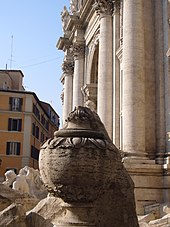
CHEAP TRAVEL EUROPE
TREVI FOUNTAIN

The Trevi Fountain (Italian: Fontana di Trevi) is a fountain in the Trevi rione in Rome, Italy. Standing 25.9 meters (85 feet) high and 19.8 meters (65 feet) wide,[citation needed] it is the largest Baroque fountain in the city and one of the most famous fountains in the world
Pre-1629 history of the aqueduct and the fountain site
The fountain at the junction of three roads (tre vie)[1] marks the terminal point[2] of the "modern" Acqua Vergine, the revived Aqua Virgo, one of the ancient aqueducts that supplied water to ancient Rome. In 19 BC, supposedly with the help of a virgin, Roman technicians located a source of pure water some 13 km (8 miles) from the city. (This scene is presented on the present fountain's façade.) However, the eventual indirect route of the aqueduct made its length some 22 km (14 miles). This Aqua Virgo led the water into the Baths of Agrippa. It served Rome for more than four hundred years.[3] The coup de grâce for the urban life of late classical Rome came when the Goth besiegers in 537/38 broke the aqueducts. Medieval Romans were reduced to drawing water from polluted wells and the Tiber River, which was also used as a sewer.
The Roman custom of building a handsome fountain at the endpoint of an aqueduct that brought water to Rome was revived in the 15th century, with the Renaissance. In 1453, Pope Nicholas V finished mending the Acqua Vergine aqueduct and built a simple basin, designed by the humanist architect Leon Battista Alberti, to herald the water's arrival.[4]
Commission, construction and design
In 1629 Pope Urban VIII, finding the earlier fountain insufficiently dramatic, asked Gian Lorenzo Bernini to sketch possible renovations, but when the Pope died, the project was abandoned. Though Bernini's project was torn down for Salvi's fountain, there are many Bernini touches in the fountain as it was built. An early, striking and influential model by Pietro da Cortona, preserved in the Albertina, Vienna, also exists, as do various early 18th century sketches, most unsigned, as well as a project attributed to Nicola Michetti[5] one attributed to Ferdinando Fuga[6] and a French design by Edme Bouchardon.[7]
Competitions had become the rage during the Baroque era to design buildings, fountains, and even the Spanish Steps. In 1730 Pope Clement XII organized a contest in which Nicola Salvi initially lost to Alessandro Galilei — but due to the outcry in Rome over the fact that a Florentine won, Salvi was awarded the commission anyway.[8] Work began in 1732, and the fountain was completed in 1762, long after Clement's death, when Pietro Bracci's Oceanus (god of all water) was set in the central niche.

Salvi died in 1751, with his work half-finished, but before he went he made sure a stubborn barber's unsightly sign would not spoil the ensemble, hiding it behind a sculpted vase, called by Romans the asso di coppe, "the "Ace of Cups".
The Trevi Fountain was finished in 1762 by Giuseppe Pannini, who substituted the present allegories for planned sculptures of Agrippa and "Trivia", the Roman virgin.
Iconography
The backdrop for the fountain is the Palazzo Poli, given a new facade with a giant order of Corinthian pilasters that link the two main stories. Taming of the waters is the theme of the gigantic scheme that tumbles forward, mixing water and rockwork, and filling the small square. Tritons guide Oceanus' shell chariot, taming hippocamps.
In the centre a robustly-modelled triumphal arch is superimposed on the palazzo façade. The centre niche or exedra framing Oceanus has free-standing columns for maximal light and shade. In the niches flanking Oceanus, Abundance spills water from her urn and Salubrity holds a cup from which a snake drinks. Above, bas reliefs illustrate the Roman origin of the aqueducts.
The tritons and horses provide symmetrical balance, with the maximum contrast in their mood and poses (by 1730, rococo was already in full bloom in France and Germany).
Coin throwing
A traditional legend holds that if visitors throw a coin into the fountain, they are ensured a return to Rome.[9] Among those who are unaware that the "three coins" of Three Coins in the Fountain were thrown by three different individuals, a reported current interpretation is that two coins will lead to a new romance and three will ensure either a marriage or divorce. Another reported version of this legend is that it is lucky to throw three coins with one's right hand over one's left shoulder into the Trevi Fountain.
An estimated 3,000 euros are thrown into the fountain each day.[10] The money has been used to subsidize a supermarket for Rome's needy.[10] However, there are regular attempts to steal coins from the fountain.[10][11][12]


